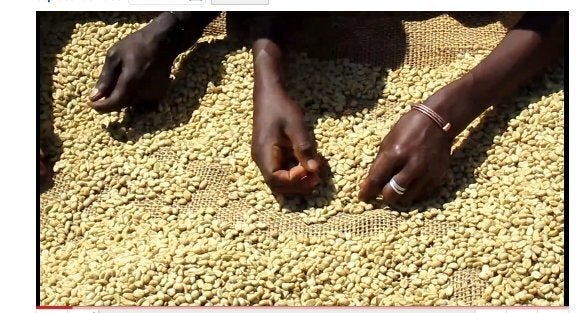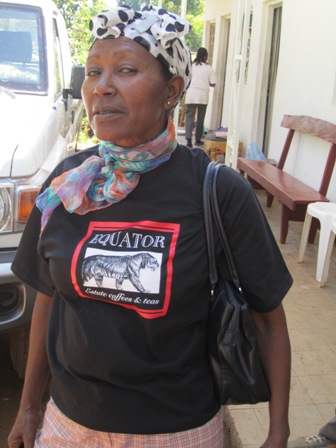
Ethiopia is the birthplace of coffee, and you can still find it growing wild in the forests of Kaffa. On a December trip to Ethiopia I tasted a Kaffa "forest" coffee - mother nature's bounty - it had tremendous body and was decidedly floral. Yes, I thought, this is how coffee was meant to be! The truth is that I tasted many fine coffees and toured some beautiful farms and mills on a two week trek around the coffee regions of southern Ethiopia. There was so much to love - the people, the food, the raw quality of Ethiopian coffee. Amazing. There was also a lot to worry about - extreme poverty, low yields, climate change, bureaucracy, record-high coffee prices. In the end, I came away with the feeling that despite all of the stumbling blocks, consumers can expect some great Ethiopian coffees for 2011.
As the Green Coffee Buyer for Equator Coffees & Teas, trips like this help me strengthen my ties to coffee farmers and exporters, helping Equator guarantee access to the world's finest coffee, and supporting farmers by understanding their lives a little better. I was awed as I listened to dozens of women and men singing beautifully as they sorted coffee at the Keleltu Hase Golam mill in Yirgacheffe, their songs timed perfectly to the fluid movements of their hands, under-ripe cherries being plucked from the drying beds with a fluency that comes from a lifetime of experience. In broken yet confident English, the 21 year old director, Muluken Beri showed me around the impeccably clean and well-organized cooperative mill. It was inspiring.
Behind this exotic façade, however, the reality can be hard to accept. Most Ethiopian children work to help support their families, especially in the agricultural sector. The average income in Ethiopia is $400 a year and many coffee farmers earn even less. Despite record high prices for coffee this year, most coffee farmers will still face poverty because their plots are so small and because their yields are low due to poor soils, climate change and lack of technical know-how. Picking coffee with their parents, or helping sort coffee in mills, children therefore earn much needed extra income for their families.
Perhaps this is why I found the small community of Aleta Wondo so inspiring. Located in the region of Sidama, Aleta Wondo is about an hour's drive from Dila, the center of the region. Ethiopian members of our California community set up a non-profit organization there, Common River, devoted to education, health and, of course, coffee. For just $700 a month, Common River operates a school that serves 122 children, providing a real education and nutritious food. As a coffee buyer it is extremely gratifying to buy from Aleta Wondo where I can see that my purchase has a direct and measurable impact.
The coffee from Aleta is outstanding as well. Much of it is grown at over 2000 meters, an impressively high altitude that makes coffee buyers smile (rule of thumb, high altitude=high quality). Full of jasmine and bergamot orange, this floral bomb is a coffee to contend with. The challenge will be getting the 2011 harvest out of Ethiopia intact. A recent change in the law requires that Aleta Wondo sell its coffee to the Ethiopia Commodity Exchange (ECX) where it becomes a generic Sidamo B coffee - losing its traceability back to the mill. Unfortunate as this is, it is possible, if you know the right people, to guarantee that a particular coffee like the Aleta Wondo is not blended with any others. This adds cost, and is a headache, but the extra effort will be well worth it because the Aleta Wondo is one of a kind.
The ability to export directly can have tremendous benefits for a community. Take Amaro Gayo, a relatively unknown region a couple of hours to the south and west of Aleta Wondo, as an example. Until three years ago no-one had heard of it. Then this region distinguished itself by efficiently exporting top quality naturals (dried in the fruit) at a time when such coffees were difficult to find. The reason? Amaro Gayo, and more specifically one woman in the community, Asnakech Thomas, had an export license. Ethiopian law requires that exporters have at least 30 hectares of land, which Asnakech does. Through her, a handful of farmers found a way to sell their coffee directly, bypassing the ECX.  And because the coffees were so good, they sold for double the rate of other coffees in this region. This has allowed farmers to reinvest in their community, and in their coffee farms, further improving quality. This is a win-win scenario, benefitting farmers and consumers. Asnakech dreams of creating a cooperative as well as gaining a regional designation for Amaro Gayo, instead of the generic Sidamo B label it currently carries. Meanwhile consumers can enjoy her community's delicious, fruit forward coffees.
And because the coffees were so good, they sold for double the rate of other coffees in this region. This has allowed farmers to reinvest in their community, and in their coffee farms, further improving quality. This is a win-win scenario, benefitting farmers and consumers. Asnakech dreams of creating a cooperative as well as gaining a regional designation for Amaro Gayo, instead of the generic Sidamo B label it currently carries. Meanwhile consumers can enjoy her community's delicious, fruit forward coffees.
The bottom line is that Ethiopia is a challenging coffee origin, yet it still manages to find ways to export some of the world's finest coffees almost every year. Despite grinding poverty, low yields, unpredictable weather and impenetrable bureaucracy, chances are 2011 will be no exception. Despite the sticker shock consumers will receive due to record high coffee prices, they will be able to enjoy some great quality coffees with the knowledge that farmers are receiving a much appreciated windfall.